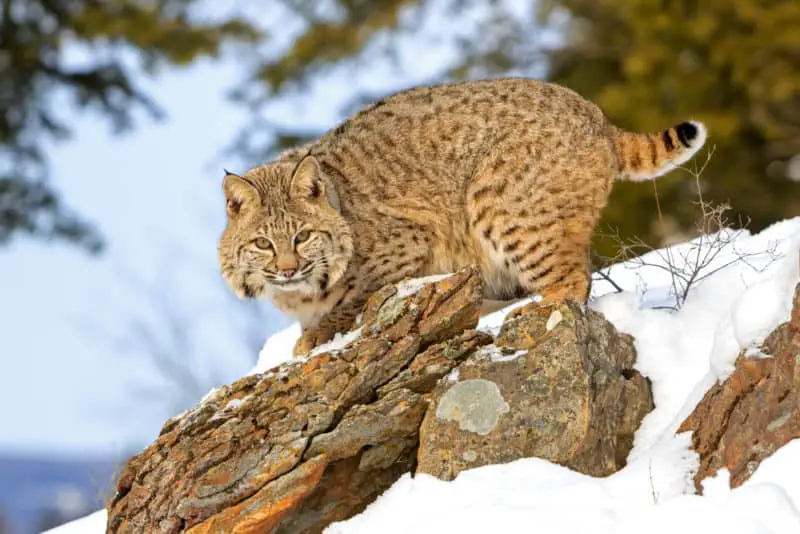According to the Texas Parks and Wildlife Department, the state is home to seven wild cats. Six of these, the mountain lion, the bobcat, the ocelot, the jaguarundi, the jaguar, and the margay, are native to the state. Feral domestic cats also have a large population in Texas. We will talk about each of these feline predators in the paragraphs below.
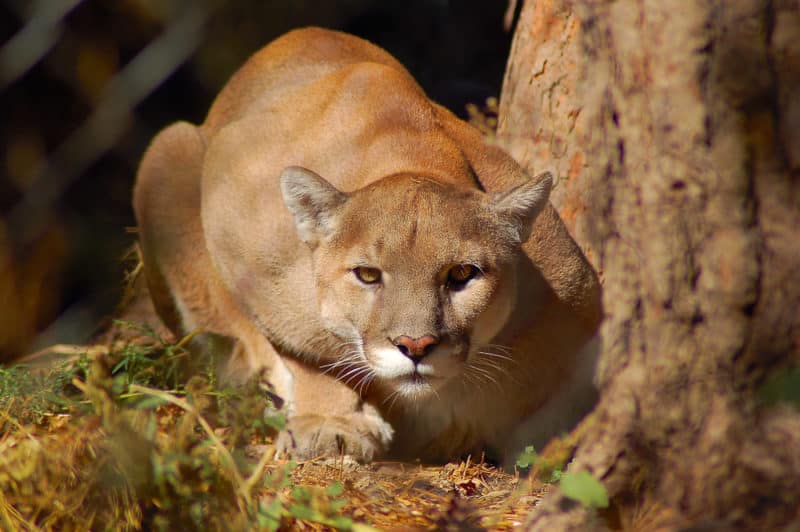
Texas Mountain Lion (Puma concolor)
Mountain lions have several different names that are interchangeable. The name that humans give them depends on the geographic region. Some of the names that people in different parts of the United States give these animals include cougar, puma, and Florida panther.
What Do Mountain Lions Look Like?
General Appearance
- A mountain lion resembles a domestic cat with short tan hair and a lean, muscular build.
- Mountain lions are much larger than domestic cats, though. One of these feline predators is 11 to 26 times larger than a typical house cat.
Body Structure
- Head: Rounded with upright, oval-tipped ears.
- Body: Longish, muscular, feline.
- Tail: Long, and muscular. Their proportionately long tail accounts for nearly one-third of their total length.
- A fun fact is that they use their tails as a counterbalance and a rudder. This is handy as they scramble over difficult terrain or make sudden directional changes.
Coat and Coloration
- Primary Color: Light brown, short, and coarse hair covers most of the body.
- Distinctive Markings:
- Black on the area around the nose, ear tips, and tail tip.
- White fur on the belly, upper lip area, lower lip, and chin.
- Dark hair is scattered on their back. This can vary with geographic location.
Size Differences Between Males and Females
- AdultMales:
- Typically, 30–40% larger than females.
- Weigh between 110–180 pounds (50–82 kg), with rare individuals over 200 pounds (91 kg).
- Length: 6–8 feet (1.8–2.4 meters) from nose to tail tip.
- Adult Females:
- Weigh between 80–130 pounds (36–59 kg).
- Length: 5–7 feet (1.5–2.1 meters).
Mountain Lion Comparison with Other Wildcats
- Mountain lions are the Fourth largest wildcat in the world.
- They are smaller than the African lion, the tiger, and the jaguar but larger than leopards.
- After the jaguar, they are the second largest wild cat in the Americas.
Unique Characteristics
- Purring: Mountain lions can purr but can’t roar. This distinguishes them from the four big cats mentioned above and places them in a different genus.
- Taxonomic Classification:
- They are part of the Felis genus due to their inability to roar.
- They are distinguished from “big cats” like African lions and leopards in the Panthera genus, which can roar but not purr.
Mountain Lion Kittens
Mountain lion kittens or cubs (either word is acceptable) have camouflaging patches and rings around their tails that gradually fade away as they mature. Their camouflage markings will be gone by the time they’re six months old.
Where Do Mountain Lions Live?
Mountain lions are found across the Americas, from Canada’s Yukon to Patagonia in Argentina.
In Texas, mountain lion sightings have occurred in all 254 counties. However, they are most common in the Trans-Pecos region (far west Texas), the brushlands of south Texas, and parts of the Texas Hill Country in the south-central part of the state.
What Do Texas Mountain Lions Eat?
Mountain lions are opportunistic predators that hunt alone from dark to morning, stalking their prey (mainly deer in the U.S. and Canada) from behind. On average, a mountain lion must kill a deer or the equivalent of a deer in biomass once a week.
In Texas, besides deer, mountain lions prey on the following animals:
- elk
- feral horses
- coyotes
- small mammals
- feral hogs
- javelina
- birds
- reptiles
- amphibians
- livestock
- pets
- Any local wildlife they can catch.
They may move the meal to a different location and cover it with dry leaves, grass, or pine needles to keep it safe from other animals. A mountain lion may return to the spot many days later to eat.

Texas Bobcat (Lynx rufus)
The bobcat is a species of lynx related to the Canada lynx. It is exclusively a North American wild cat and the most common wild cat species in North America.
Biologists believe that both the bobcat and the Canada lynx are descendants of the Eurasian lynx, and their ancestors crossed into North America via the Bearing Sea land bridge.
Taxonomy of Texas Bobcats
At times, biologists have divided the bobcats of Texas into two subspecies. Namely, these are the desert bobcat that lives in the western and northwestern part of the state and the Texas bobcat that lives in the rest of the state.
This is not the case today, though. Since the revision of cat taxonomy in 2017, there are 2 recognized subspecies of bobcats. They are (Lynx Rufus Rufus), which lives east of the Great Plains, and (Lynx Rufus Fasciatus), which lives west of the Great Plains.
What Do Bobcats Look Like?
Bobcats are smaller than mountain lions and slightly smaller than Canada lynx, with smaller female bobcats being only slightly larger than large domestic cats. Here’s a detailed breakdown of their physical characteristics:
Size and Weight:
- Length: 2 to 3 feet.
- Weight: Typically between 15 to 35 pounds, with females significantly smaller than males.
Tail and Body Markings:
- Short, “bobbed” tail with a distinctive black tip.
- Fur color: Ranges from gray to brown, with mottled dark spots in shades from black to dark brown.
- Markings: Black stripes are visible on their inner forelegs and tails.
Body Shape:
- The rump sits slightly higher than the shoulders, giving them a unique profile.
- Long hind legs compared to shorter forelegs, similar to the structure seen in lynx.
Ear and Facial Features:
- Ear tufts: Black tufts of hair that rise above each ear.
- Earbacks: Black with a central white spot, creating a “false eye” appearance.
- Face: Broad and whiskered, with long, ruffled facial hair enhancing the width of their face.
- Eyes: Yellow or greenish-yellow with black, vertical elliptical pupils.
Bobcats are fierce animals. If you get one cornered, it will hiss, growl, and spit like one of the nastiest house cats you’ve ever run into x a million. They mean it, too. They have to be tough and mean to survive.
Where Do Bobcats Live?
These small wild cats live in three North American countries. Their range begins in southern Canada and extends south through most of the United States and into central Mexico.
According to Texas Parks and Wildlife, bobcats live throughout the “Lone Star State”. They are particularly abundant in the south Texas brush country.
These feline predators are mostly crepuscular or nocturnal, but it’s not uncommon to see one in the daytime because they only sleep for 2 to 3 hours at a time.
What Do Bobcats Eat?
Even though they’re small, Texas bobcats are aggressive, tough predators. Sometimes, particularly in the winter, they prey on animals much larger than they are, such as deer. However, their regular diet consists of :
- Small mammals: such as rabbits, mice, wood rats, and ground squirrels.
- Birds: Ground nesting birds, such as meadowlarks, wild turkeys and prairie chickens are most at risk to bobcat predation.
- Reptiles and amphibians. (See the fun fact at the bottom of this section.)
- Carrion: Bobcats generally prefer fresh killed meat but will resort to eating carrion if they can’t find anything else.
- In agricultural or urban areas, bobcats may prey on household pets or small livestock.
A fun fact is that bobcats prey on venomous snakes despite being not immune to venom. They get this done by using their quickness to pin the snake’s head to the ground with a paw. At this point, they kill the snake by biting the spine behind the head. Texas is home to fourteen venomous snake species.
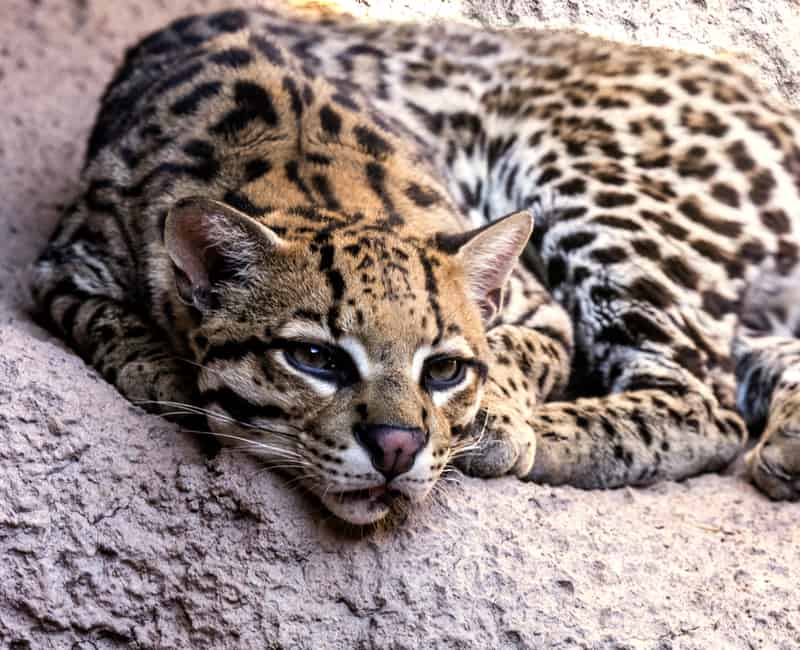
Texas Ocelot (Leopardus pardalis)
Ocelots are distinctively marked Texas native wild cats. They once ranged over much of Texas and parts of Arkansas, Arizona, and Louisiana. Today, though, their diminutive U.S. population is restricted to a small part of south Texas.
Physical Characteristics
- Size: Adults weigh between 24 and 35 pounds (10.88 to 15.87 kg) and measure 28 to 35 inches (71.12 to 88.9 cm) in length. Their tails can add up to 18 inches (45.72 cm).
- Coat: Their fur ranges from creamy yellow to gray with intricate black markings. Black lines run along their necks to their tails, while their necks and undersides are white. They also have white spots on a black background behind each ear.
- Unique Patterns: Each ocelot has a distinct coat pattern. This makes it possible to identify individual animals.
What Do Ocelots Eat?
Ocelots primarily prey on small mammals, but their diet also includes:
- Common Prey: Birds, reptiles, amphibians, crustaceans, fish, and insects.
- Regional Variations:
- In Central and South America, they may hunt small monkeys and iguanas.
- In the desert southwest of the United States, they target rodents, armadillos, deer fawns, and rabbits.
Where Do Ocelots Live?
Ocelots live on all three American continents:
- Geographic Range: In the Americas, ocelots live in the southwestern United States and in every country south of the U.S. except Chile. See
- U.S. Habitats:
- Southern Texas: These small cats live in several isolated populations on the Rio Grande Plains. Texas has an estimated population of 50 to 80 ocelots.
Threats to Texas Ocelots
Habitat loss is the greatest challenge facing Texas ocelots.
- Historical Decline: By 1986, less than 1% of the lower Rio Grande Valley provided optimal habitat, primarily due to agricultural and urban development.
- Current Status: Conservation efforts focus on preserving and restoring their limited habitat.
- The Ocelot subspecies that inhabit southern Texas and northeastern Mexico are protected under the Federal Endangered Species Act.
Challenges of Keeping Ocelots as Pets
Though some people keep ocelots as exotic pets, they pose significant challenges:
- Natural Instincts: As wild cats, ocelots are driven to hunt, potentially endangering neighboring pets.
- Destructive Behavior: They can damage carpets and furniture.
- Odor Issues: Their urine and feces have a strong, unpleasant smell, and they instinctively scent-mark their territory.
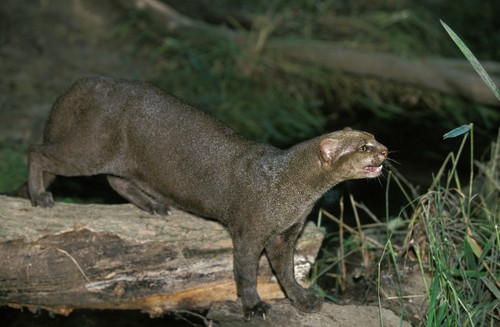
Texas Jaguarundi (Herpailurus yaguarondi)
Jaguarundis are small wild cats native to North, Central, and South America. While they resemble large domestic cats in size, their unique features set them apart. These animals have an elongated body, proportionately short legs, and a narrow head with wide-set, small ears. This combination gives them a slight resemblance to mustelids rather than typical cats.
Physical Characteristics:
- Color Morphs: Jaguarundis occur in two color variations—grey or brown.
- Size: Adult jaguarundis stand about 14 inches (35.56 cm) at the shoulder.
- Weight: They weigh between 6.6 to 15 pounds (3 to 6.8 kg).
What Do Jaguarundis Eat?
Jaguarundis prey on small mammals, reptiles, and birds.
Where Do Jaguarundis Live?
Jaguarundis are found across a vast range stretching from Argentina through Central and South America, Mexico, and into the desert southwest of the United States, including Texas, New Mexico, and Arizona. However, their presence in Texas is uncertain.
The Texas Parks and Wildlife Department (TPWD) lists jaguarundis as endangered and notes they are likely expatriated from the state. There have been only five recorded sightings in Texas’s history, the last being a roadkill incident in 1986. According to Jonah Evans, TPWD’s Nongame and Rare Species Program leader, jaguarundis were likely never abundant in Texas.
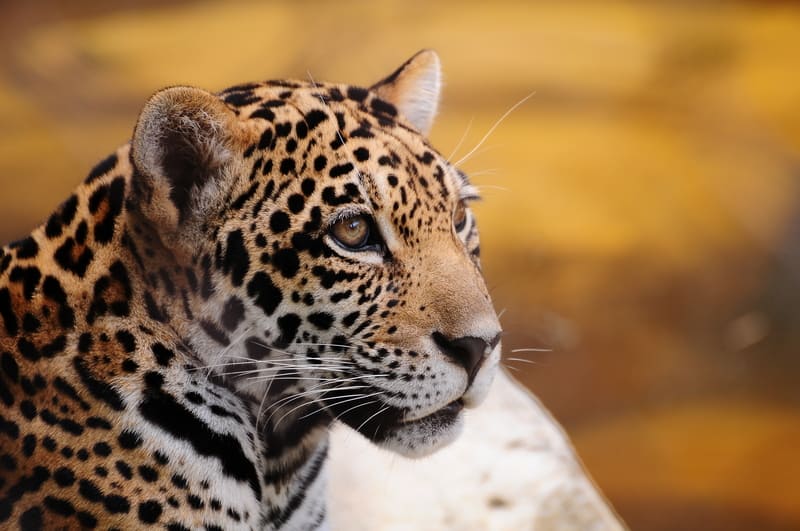
Jaguars in Texas (Panthera onca)
Jaguars are the only member of the Panthera genus—the “big cat” genus—native to the Americas. They hold several distinctions:
- Largest Cat in the Americas: Jaguars are the largest wild cat across North, Central, and South America.
- Third Largest Wild Cat in the World: Only tigers and African lions surpass them in size.
Physical Characteristics:
- Size: Jaguars stand 26.8 to 29.5 inches (68 to 75 cm) at the shoulder.
- Length: Their body length, from nose to rump, ranges from 3 feet 8 inches to 6 feet 1 inch (1.12 to 1.85 m).
- Weight: They weigh between 123–212 pounds (56–96 kg), with males being 10–20% larger than females.
Jaguars have a stout, muscular build with proportionately short legs compared to other big cats. They resemble leopards but are stockier. Their coat varies from light tan to orange, marked by black rosette-shaped spots. Rare melanistic jaguars, also known as black panthers, are entirely black.
What Do Jaguars Eat?
As apex predators, jaguars are opportunistic hunters, preying on a wide variety of animals:
Texas and Arizona: Jaguars consume prey similar to those found in Sonora, Mexico, such as deer, pronghorns, javelinas, reptiles, rabbits, and packrats.
South and Central America: They hunt monkeys, capybaras, tapirs, caimans, and even fish, which they catch using their tails as lures.
Mexico: Their diet overlaps with mountain lions, with deer forming a large part of their meals.
Where Do Jaguars Live?
Jaguars inhabit 18 countries across the Americas, from Patagonia in the south to northern Mexico and the U.S. border. Historically, they roamed southern Texas, New Mexico, Arizona, and as far north as the South Platte River in Colorado.
Since 1996, seven jaguars have been sighted in the U.S., all males spotted in southern Arizona or southwestern New Mexico. Biologists believe these males were exploring new territories from the main breeding population in Sonora, Mexico.
One famous jaguar, nicknamed El Jefe (“The Boss”), was the only known wild jaguar in the U.S. from 2011 to 2015. He was frequently spotted in southern Arizona before disappearing. Recently, El Jefe was rediscovered in Sonora, Mexico, approximately 120 miles south of his last sighting in Arizona. Source
Jaguars in Texas
Jaguars were once common in southern and eastern Texas. However, biologists believe they have been expatriated from their former range in the state. The last Jaguar in Texas that was documented to be the real thing was killed in 1948.

Texas Margay (Leopardus wiedii)
Margays are similar to ocelots in their coloration and markings. However, they are smaller and more slenderly built than the former.
Colonel S. Cooper shot a margay at Eagle Pass, Texas, over 100 years ago. This is the one and only margay ever recorded in the state other than fossil remains that exist along the Sabine River in Orange County. Source
Although there haven’t been any recent margay sightings in Texas, the animals live across the Rio Grande in the Mexican state of Tamaulipas.
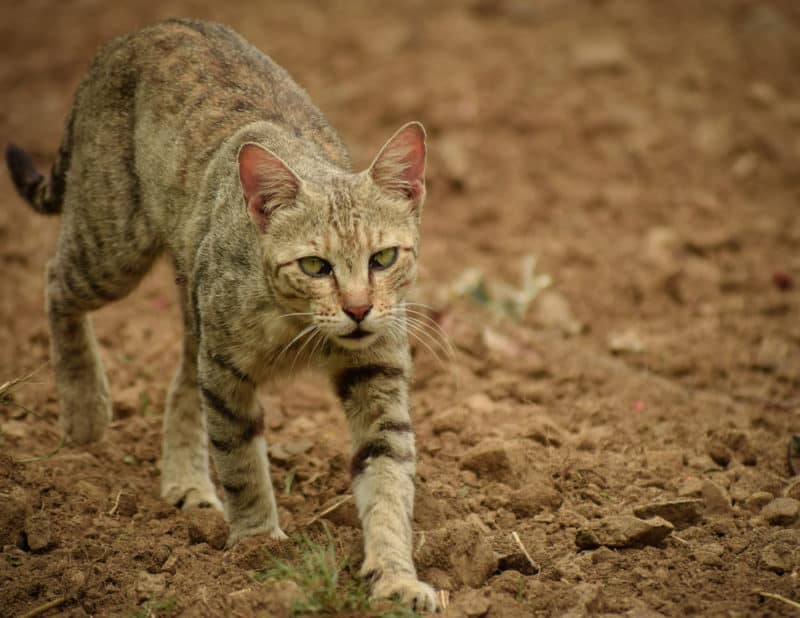
Feral Domestic Cats in Texas (Felis catus)
At first glance, it’s odd that the TPWD would count feral domestic cats as resident wild cats. However, feral cats can populate very fast. So consequently, they can have a large impact on a wildlife community. To quote the TPWD, “In the course of a bobwhite quail experiment in East Texas, cats killed eight quail and ten cardinals in the experiment traps, on one occasion six quail at one time.” See
Conclusion
Texas is home to stable breeding populations of mountain lions and bobcats. Another Texas native wild cat species, the ocelot, is listed as an Endangered Species. Only 50 to 80 ocelots exist in the Texas wilds. Three other wild cat species are native to Texas but it is questionable whether or not they still exist within the state. These are the jaguar, the jaguarundi, and the margay. Although they are not native species, feral domestic cat numbers in Texas are large enough to be ecologically significant. Feral cats take prey animals away from native species and spread disease.
Conservation efforts are crucial to preserving Texas’ native wild cats and ensuring that they continue to thrive in Texas for generations to come. By understanding their behaviors, habitats, and the threats they face, we can foster a greater appreciation for these wild cats. Appreciation necessarily leads to actions taken to protect them.
Also, see:
Wild Cats In Arizona – Krebs Creek
Wild Cats In New Mexico – Krebs Creek
Recent Posts
The only venomous snakes in Washington State are Northern Pacific Rattlesnakes. The Northern Pacific Rattlesnake (Crotalus oreganus oreganus) is a sub-species of the Western Rattlesnake. Anyone...
Skunks are not classified as true hibernators. But they go into a state of torpor when the weather gets cold. Skunks are light sleep hibernators, along with opossums, bears, and raccoons. ...

